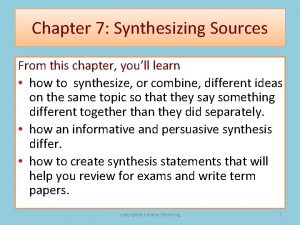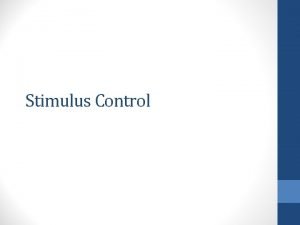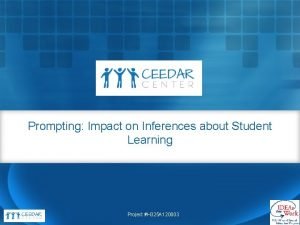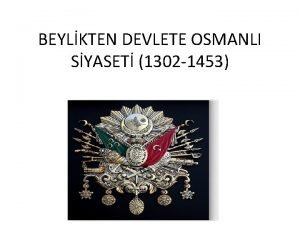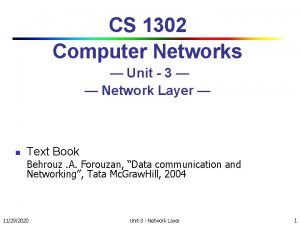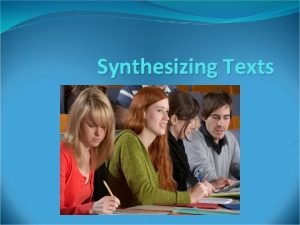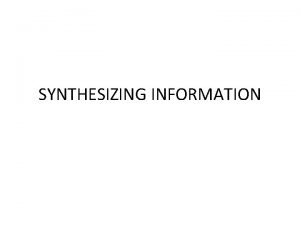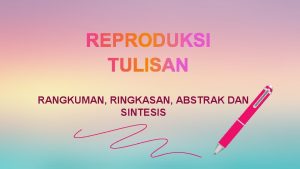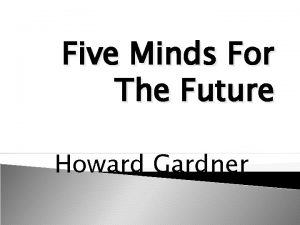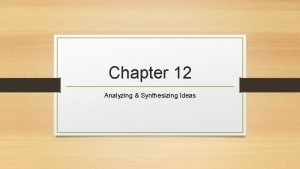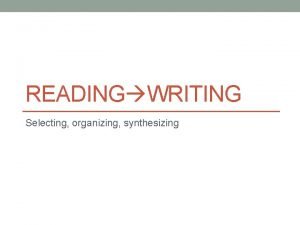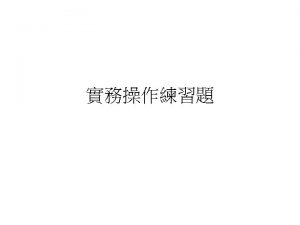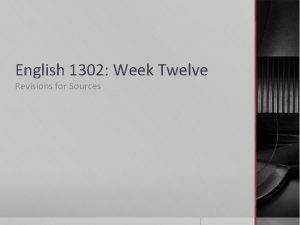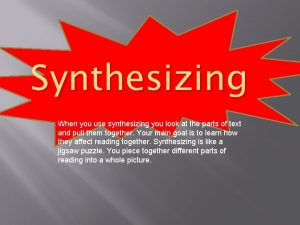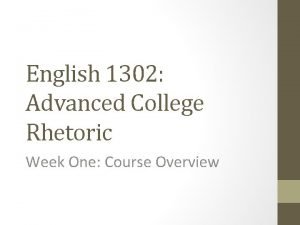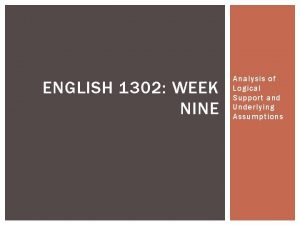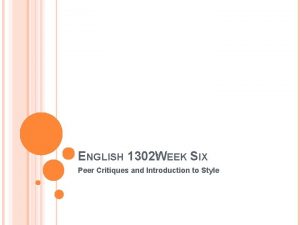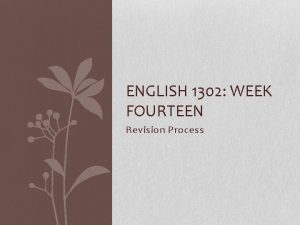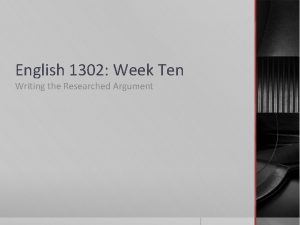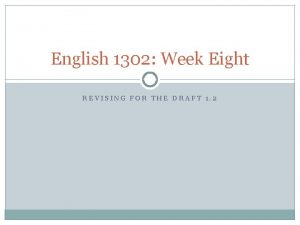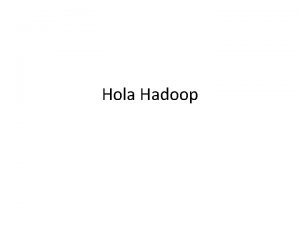ENGLISH 1302 WEEK THREE Synthesizing Sources PROMPT Please










![EXAMPLE SYNTHESIS BODY PARAGRAPH From Yarbro ugh’s 1. 2: “ [Top ic Sentence] Rese EXAMPLE SYNTHESIS BODY PARAGRAPH From Yarbro ugh’s 1. 2: “ [Top ic Sentence] Rese](https://slidetodoc.com/presentation_image_h2/1ebb873e6e058e2f6fa72e19c877cc90/image-11.jpg)


![WWI SYNTHESIS: ANNOTATED “ [Hook] World War I saw one of the greatest outpourings WWI SYNTHESIS: ANNOTATED “ [Hook] World War I saw one of the greatest outpourings](https://slidetodoc.com/presentation_image_h2/1ebb873e6e058e2f6fa72e19c877cc90/image-14.jpg)

- Slides: 15

ENGLISH 1302: WEEK THREE Synthesizing Sources

PROMPT Please get out your homework assignments (Library Assignment, Annotations) and have those ready. While we wait for class to begin, please read Charles Knight’s sample Brief Assignment 2 in your First-Year Writing Textbook p. 585. Note how the body paragraphs are structured in relation to thesis.

CLASS OVERVIEW Announcements, Reminders, and Due Dates Introduction to Synthesis Identifying Synthesis Language Literature Review Formal Requirements and Language Review of Yarbrough’s Literature Review 1. 2 Synthesis Exercise: Poetry of World War I Homework: Library Assignment, Topic Proposal, and Brief Assignment 2

ANNOUNCEMENTS Upcoming Brief Assignment 2 Library Assignment due in class next week (2/11) (make sure to retain a copy for yourself!) (. 5 of a point off for each day late). Formal Topic Proposal due by e-mail next week (no later than midnight 2/12) University Writing Center Appointments

INTRODUCTION TO SYNTHESIS Synthesis is a technique that “groups similar pieces of information together” and establishes patterns between different texts. § Think of synthesis as a “combining” or drawing together of elements: this is how you identify themes and elements of a scholarly conversation for your reader. Synthesis is the core writing skill for the literature review, as your body paragraphs should be devoted to synthesizing articles based on subtopics of your research topic. Synthesis in a literature review should involve explicit, qualitative comparisons between authors’ arguments and their various sub-points and concerns. An effective synthesis essay will require you to draw on summary and paraphrase skills but should operate by connecting authors’ arguments. Synthesis requires that you examine not just simple matters of agreement but varying degrees of overlap and even disagreement between authors.

IDENTIFYING SYNTHESIS LANGUAGE Formally, synthesis of arguments should focus on the authors and their articles within the sentence. § Ex: Whereas Barker’s research argues that metaphor is significant to Dickinson’s poetry because of the way it relates to self-exploration and “lyric identity, ” Weisbuch identifies not metaphor but metonymy in conjunction with Dickinson’s poetry. Moreover, he believes that metonymy signifies a dissolution of identity as opposed to the expansion or exploration Barker suggests (Weisbuch 233). Synthesis will require you to discuss at least two authors in context with one another within the same sentence. Effective synthesis should not attempt to summarize each author alone in their own paragraph; your paragraphs’ topic sentences should identify the common subtheme shared by two authors or more. Synthesis often employs comparative phrases, complex sentence structure, and signal verbs to incorporate multiple authors’ views. Where in Yarbrough’s 1. 2 did we see these phrases?

BRIEF ASSIGNMENT 2 BA 2 ask s yo u to write an essay that synthesizes the main poi nts of three arti cle s: Birk erts’s “Into t he Electronic Millennium, ” Budiansky’s “Lost in Tran slat ion, ” and Rosenbe rg ’s “Everyone Speak’s Text Mess age” (all in your FY W te xt bo ok). Sh ould be writte n in the third-person (no use of “I”) and must focus on the auth ors and the conne ctions between their arguments/purpo ses. Your th esis sentence shou ld identify theme common to all three articles an d allo w yo u to identify su b-p oints for your body paragraphs. Alt hough the assignme nt is 400 -600 words total, you must i nclude a sufficient in tro ductory paragraph and concluding paragraph in additi on to two body para graphs of synthe sis. The body paragraphs should be subs tantially de velo pe d (i. e. not shorte r t han your conclusion or intro) and must contain tex tual e vide nce (paraphrases or brief direct quotes) to suppo rt your synthesis of th e so urces. Be spe cific in your comparisons ! Ple ase be sure to include topic sentences that identify the po int around which you will synthesize the sou rces. You must include an MLA-format works cited entry (labeled Works Cited) at the end o f yo ur work. Not inclu ding attribution for your sources i s akin to pla giarism. In-te xt citations for paraphrases, quotes, and any idea taken dire ct ly fro m the text must be included. Pro of re ad care fully and make sure that you are referring to authors by their last nam es afte r the ir full names have been established in the intro paragraph.

INTRO AND CONCLUDING PARAGRAPHS Your introduction should be modeled after the structure of our WWI example (coming up in this Powerpoint, slides 13/14). Your introduction should include: § A one sentence hook/statement of exigency that focuses on the researchers and their arguments § A clear two sentence summary of the overall debate or concern in the essays. § A statement containing the articles’ titles and authors’ names as well as the general theme that connects them. § A thesis that indicates the trend in research and connects the three authors. Your conclusion should include: § A concise summary of thesis and comparisons or differences that arrived from the synthesis.

BRIEF ASSIGNMENT 2 DIRECTIONS CONT’D Nearly every sentence should involve more than one author’s article. Paragraphs should be organized by theme and not by individual articles. When drawing comparisons for synthesis, make sure that you are using correct source integration technique: look at the example BA 2 on 584 -5 and Yarbrough’s 1. 2 (both in FYW) for models. Also, you will want to review Ch. 13 in your St. Martin’s Handbook for additional guidance on source integration. Practice active reading and make sure to use the checklist provided on the following slide (and on the blog) to help you identify the arguments of each article before you begin drafting your BA 2. Make sure not to use excessive direct quotes: you do not have the space. Your assignment will be docked points if you use excessive or long direct quotes. Practice concision.

READING CHECKLIST For each article you read for BA 2, please note the following as you take notes: q Identify the specific theme of the article (must be narrower than “technology” or “reading”(“technology” could mean “washing machines” if left undefined): what problem are they concerned with? What relationships or ideas? ) q Identify the argument: what does the author want his or her audience to do or believe? What’s at stake? q How do they form their argument? Why do these techniques matter? q Who is the audience, and when was the piece written? (Hint: this will alter how the authors examine their themes and form their argument). q What are some textual examples you could use to identify an aspect or sub-point of the author’s argument?
![EXAMPLE SYNTHESIS BODY PARAGRAPH From Yarbro ughs 1 2 Top ic Sentence Rese EXAMPLE SYNTHESIS BODY PARAGRAPH From Yarbro ugh’s 1. 2: “ [Top ic Sentence] Rese](https://slidetodoc.com/presentation_image_h2/1ebb873e6e058e2f6fa72e19c877cc90/image-11.jpg)
EXAMPLE SYNTHESIS BODY PARAGRAPH From Yarbro ugh’s 1. 2: “ [Top ic Sentence] Rese arch agr ees in addition to line spacing, bi gger text size is ben ef i cial fo r child re aders. Sue Walker strongly states that “si ze of typeface” is the “m ost impo rtant factor in the influence of books upon visi on” (Describing 196). H owe ver , Walke r’s stu dies are not completely relevant s ince they revolve around childre n’s books from the early 1900 s, but her reports still consider the impo rtan ce of de sign and th e needs of beginning learners and their perceptions of word s. Likewise , Laura E. Hu ghes and Arnold J. Wilkins encourage larger word size sin ce they be lie ve type may be too small for effective reading com preh en sion (Typography 410). They agree with Walker by stating that font size usually ge ts smaller as a r esult of smaller lettering and s tate it could hinder perform an ce and slow spee d (Typography 315). Hughes and Wi lkins are also more urgen t t han Walker by calling for a change in books by educators. In a more rec en t article, Arnold J. Wilkins observes reading speed in rel ati onship to word size, but unlike his e arlie r st udy with Hughes he does not focus on com preh en sion. He finds that lar ger font is beneficial for both younger and older children. I n addition , both st udies agree that larger word size designed for youn ge r ch ildren was re ad fast er by older children, thus larger type size was ben ef i cial to all ages. Whe n comparing Wilkins and Walker , Wil kins is more detailed in field rese arch by t esting children, while Walker fo cus es more on the genera l effe ctiveness of wor d siz e in the design of children’s bo oks. [Concluding Sent ence] Nonethe less, Walker, Hughes, and Wilkins recognize that adjusting word size is an important fact or to consider and can affect the way children learn to re ad. ”

ANNOTATIONS In the previous slide, authors’ names are underlined and signal phrases for synthesis are bolded. When a third author is brought directly into a sentence via comparison, they are marked in red. Likewise, phrases that pulled all authors together were marked in blue. The topic sentence discusses all authors and defines the paragraph’s point [sub-topic] for synthesis: agreement that “bigger text is beneficial for child readers. ” Note that Yarbrough does not only discuss basic agreement: she explores the qualitative differences and similarities between each author’s approach to the sub-topic. Note the use of details (short direct quotes, paraphrases) to support her synthesis and summary of each text.

SAMPLE INTRODUCTORY PARAGRAPH: SYNTHESIS OF WWI POETS “World War I saw one of the greatest outpourings of poetry from active soldiers than almost any war before it. During the war, soldier-poets or “trench poets” who made war their subject reacted to the traditional, patriotic art of the 19 t h century through their own poetry, often refusing the public conception of the soldier. Their poems, however, differ from one another in their approach to the role of the soldier during wartime. “Anthem for Doomed Youth” by Wilfred Owen, “Base Details” by Siegfried Sassoon, and “In Flanders Fields” by John Mc. Crae all examine the legacy of fallen soldiers in relation to the civilian public. These poets are in consensus that a soldier’s experiences are separate from those of the civilian public, although they differ in the way they believe a soldier’s legacy should be received during wartime and as part of the war effort. ”
![WWI SYNTHESIS ANNOTATED Hook World War I saw one of the greatest outpourings WWI SYNTHESIS: ANNOTATED “ [Hook] World War I saw one of the greatest outpourings](https://slidetodoc.com/presentation_image_h2/1ebb873e6e058e2f6fa72e19c877cc90/image-14.jpg)
WWI SYNTHESIS: ANNOTATED “ [Hook] World War I saw one of the greatest outpourings of poetry from active soldiers than almost any war before it. [Debate/Concern ] During the war, soldier-poets or “trench poets” who made “war” their subject reacted to the traditional, patriotic art of the 19 t h century through their own poetry, often refusing the public conception of the soldier. Their poems, however, differ from one another in their approach to the role of the soldier during wartime. [Authors and general theme] “Anthem for Doomed Youth” by Wilfred Owen, “Base Details” by Siegfried Sassoon, and “In Flanders Fields” by John Mc. Crae all examine the legacy of fallen soldiers in relation to the civilian public. *Note: nearly all sentences start with or focus on “the authors” of the texts/poems. ” [Thesis indicating research trend] These poets are in consensus that a soldier’s experiences are separate from those of the civilian public, although they differ in the way they believe a soldier’s legacy should be received during wartime and as part of the war effort. ”

HOMEWORK Read the three articles listed in BA 2 (printed in your FYW textbook) as part of BA 2 (Hint: do this early!) Complete Brief Assignment 2 in Raider Writer, due Sat. 2/8 Complete and send your formal topic proposal via e-mail (please review our class notes for Week 2 on the blog for specific details) (worth 4 points participation total). You must follow directions with this e-mail. Complete the Library Assignment (all sections) and turn in a copy in class on 2/11 (worth 8 points participation total). *Make sure not to turn in your only copy! You will need this for our class next Tuesday.
 Synthesizing sources
Synthesizing sources Response prompt vs stimulus prompt
Response prompt vs stimulus prompt Response prompt vs stimulus prompt
Response prompt vs stimulus prompt Osmanlı 1302
Osmanlı 1302 Head start performance standards 1302
Head start performance standards 1302 Cs1302 computer networks
Cs1302 computer networks Print sources of information
Print sources of information The importance of water resources
The importance of water resources Will you please be quiet please themes
Will you please be quiet please themes Week by week plans for documenting children's development
Week by week plans for documenting children's development Synthesising reading strategy
Synthesising reading strategy Steps in synthesizing information
Steps in synthesizing information Contoh sintesis perkuliahan
Contoh sintesis perkuliahan Five minds for the future howard gardner
Five minds for the future howard gardner Synthesizing ideas
Synthesizing ideas Synthesizing in reading
Synthesizing in reading
